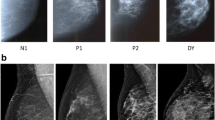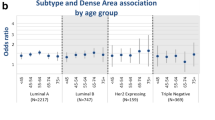Abstract
Purpose
To determine the relationship between breast density, presenting features and molecular subtype of cancer, and surgical treatment received.
Methods
Retrospective review of a prospectively maintained database. Eligible patients had stage 1–3 cancer, were treated between 1/2005 and 6/2007, and had estrogen receptor (ER), progesterone receptor (PR), and human epidermal growth factor receptor 2 (HER2) measurements and films available for review. Density was classified at presentation as 1–4 using the Breast Imaging Reporting and Data System (BI-RADS) classification.
Results
1,323 patients were included. Significant differences across the four density groups were present in age, race, multicentricity/focality, and presence of an extensive intraductal component (EIC). When density was combined into two groups, after adjustment for age, only an EIC and mammographically occult cancer were significantly more common in the dense groups. Extremely dense breasts (BI-RADS density 4) more commonly had luminal A tumors (p = 0.05), lobular cancers (p = 0.03), multicentricity (p = 0.02), and occult tumors (p < 0.0001). Greater density was associated with increased mastectomy use, with 61% of the extremely dense group having mastectomy versus 43% of those of lesser density (p = 0.01).
Conclusions
Cancers in extremely dense breasts occur in younger women, are more often mammographically occult, and appear to be phenotypically different from those arising in other density groups. The more common use of mastectomy may be related to these features, although density itself is not a selection criterion for mastectomy.

Similar content being viewed by others
References
Boyd NF, Byng JW, Jong RA, et al. Quantitative classification of mammographic densities and breast cancer risk: results from the Canadian National Breast Screening Study. J Natl Cancer Inst. 1995;87(9):670–5.
McCormack VA, dos Santos Silva I. Breast density and parenchymal patterns as markers of breast cancer risk: a meta-analysis. Cancer Epidemiol Biomarkers Prev. 2006;15(6):1159–69.
Vacek PM, Geller BM. A prospective study of breast cancer risk using routine mammographic breast density measurements. Cancer Epidemiol Biomarkers Prev. 2004;13(5):715–22.
Ma L, Fishell E, Wright B, et al. Case-control study of factors associated with failure to detect breast cancer by mammography. J Natl Cancer Inst. 1992;84(10):781–5.
Sala E, Warren R, McCann J, et al. Mammographic parenchymal patterns and mode of detection: implications for the breast screening programme. J Med Screen. 1998;5(4):207–12.
Boyd NF, Dite GS, Stone J, et al. Heritability of mammographic density, a risk factor for breast cancer. N Engl J Med. 2002;347(12):886–94.
Kelemen LE, Sellers TA, Vachon CM. Can genes for mammographic density inform cancer aetiology? Nat Rev Cancer. 2008;8(10):812–23.
Odefrey F, Stone J, Gurrin LC, et al. Common genetic variants associated with breast cancer and mammographic density measures that predict disease. Cancer Res. 2010;70(4):1449–58.
Yong M, Schwartz SM, Atkinson C, et al. Associations between polymorphisms in glucuronidation and sulfation enzymes and mammographic breast density in premenopausal women in the United States. Cancer Epidemiol Biomarkers Prev. 2010;19(2):537–46.
Aiello EJ, Buist DS, White E, Porter PL. Association between mammographic breast density and breast cancer tumor characteristics. Cancer Epidemiol Biomarkers Prev. 2005;14(3):662–8.
Roubidoux MA, Bailey JE, Wray LA, Helvie MA. Invasive cancers detected after breast cancer screening yielded a negative result: relationship of mammographic density to tumor prognostic factors. Radiology. 2004;230(1):42–8.
Perou CM, Sorlie T, Eisen MB, et al. Molecular portraits of human breast tumours. Nature. 2000;406(6797):747–52.
D’Orsi CJ, Bassett LW, Berg WA, et al. Breast imaging reporting and data system: ACR BI-RADS-mammography. Reston, VA: American College of Radiology (ACR); 2003.
Palomares MR, Machia JR, Lehman CD, et al. Mammographic density correlation with Gail model breast cancer risk estimates and component risk factors. Cancer Epidemiol Biomarkers Prev. 2006;15(7):1324–30.
Feig SA, Shaber GS, Patchefsky A, et al. Analysis of clinically occult and mammographically occult breast tumors. AJR Am J Roentgenol. 1977;128(3):403–8.
Mandelson MT, Oestreicher N, Porter PL, et al. Breast density as a predictor of mammographic detection: comparison of interval- and screen-detected cancers. J Natl Cancer Inst. 2000;92(13):1081–7.
Porter GJ, Evans AJ, Cornford EJ, et al. Influence of mammographic parenchymal pattern in screening-detected and interval invasive breast cancers on pathologic features, mammographic features, and patient survival. AJR Am J Roentgenol. 2007;188(3):676–83.
McCormack VA, Perry N, Vinnicombe SJ, Silva Idos S. Ethnic variations in mammographic density: a British multiethnic longitudinal study. Am J Epidemiol. 2008;168(4):412–21.
Morrow M, Chatterton RT Jr, Rademaker AW, et al. A prospective study of variability in mammographic density during the menstrual cycle. Breast Cancer Res Treat. 2010;121(3):565–74.
Pankow JS, Vachon CM, Kuni CC, et al. Genetic analysis of mammographic breast density in adult women: evidence of a gene effect. J Natl Cancer Inst. 1997;89(8):549–56.
Vachon CM, Sellers TA, Carlson EE, et al. Strong evidence of a genetic determinant for mammographic density, a major risk factor for breast cancer. Cancer Res. 2007;67(17):8412–8.
Wiechmann L, Sampson M, Stempel M, et al. Presenting features of breast cancer differ by molecular subtype. Ann Surg Oncol. 2009;16(10):2705–10.
Weigelt B, Horlings HM, Kreike B, et al. Refinement of breast cancer classification by molecular characterization of histological special types. J Pathol. 2008;216(2):141–50.
Fasching PA, Heusinger K, Loehberg CR, et al. Influence of mammographic density on the diagnostic accuracy of tumor size assessment and association with breast cancer tumor characteristics. Eur J Radiol. 2006;60(3):398–404.
Ma H, Luo J, Press MF, et al. Is there a difference in the association between percent mammographic density and subtypes of breast cancer? Luminal A and triple-negative breast cancer. Cancer Epidemiol Biomarkers Prev. 2009;18(2):479–85.
Seo BK, Pisano ED, Kuzimak CM, et al. Correlation of HER-2/neu overexpression with mammography and age distribution in primary breast carcinomas. Acad Radiol. 2006;13(10):1211–8.
Becker S, Kaaks R. Exogenous and endogenous hormones, mammographic density and breast cancer risk: can mammographic density be considered an intermediate marker of risk? Recent Results Cancer Res. 2009;181:135–57.
Morishita M, Ohtsuru A, Hayashi T, et al. Clinical significance of categorisation of mammographic density for breast cancer prognosis. Int J Oncol. 2005;26(5):1307–12.
Ghosh K, Brandt KR, Sellers TA, et al. Association of mammographic density with the pathology of subsequent breast cancer among postmenopausal women. Cancer Epidemiol Biomarkers Prev. 2008;17(4):872–9.
Practice guideline for the breast conservation therapy in the management of invasive breast carcinoma. J Am Coll Surg. 2007;205(2):362–376.
Morrow M, Schmidt RA, Bucci C. Breast conservation for mammographically occult carcinoma. Ann Surg. 1998;227(4):502–6.
Sabel MS, Rogers K, Griffith K, et al. Residual disease after re-excision lumpectomy for close margins. J Surg Oncol. 2009;99(2):99–103.
Moore MM, Borossa G, Imbrie JZ, et al. Association of infiltrating lobular carcinoma with positive surgical margins after breast-conservation therapy. Ann Surg. 2000;231(6):877–82.
Silberfein EJ, Hunt KK, Broglio K, et al. Clinicopathologic factors associated with involved margins after breast-conserving surgery for invasive lobular carcinoma. Clin Breast Cancer. 2010;10(1):52–8.
Park CC, Rembert J, Chew K, et al. High mammographic breast density is independent predictor of local but not distant recurrence after lumpectomy and radiotherapy for invasive breast cancer. Int J Radiat Oncol Biol Phys. 2009;73(1):75–9.
Cil T, Fishell E, Hanna W, et al. Mammographic density and the risk of breast cancer recurrence after breast-conserving surgery. Cancer. 2009;115(24):5780–7.
Millar EK, Graham PH, O’Toole SA, et al. Prediction of local recurrence, distant metastases, and death after breast-conserving therapy in early-stage invasive breast cancer using a five-biomarker panel. J Clin Oncol. 2009;27(28):4701–8.
Nguyen PL, Taghian AG, Katz MS, et al. Breast cancer subtype approximated by estrogen receptor, progesterone receptor, and HER-2 is associated with local and distant recurrence after breast-conserving therapy. J Clin Oncol. 2008;26(14):2373–8.
Carey LA, Perou CM, Livasy CA, et al. Race, breast cancer subtypes, and survival in the Carolina Breast Cancer Study. JAMA. 2006;295(21):2492–502.
Katipamula R, Degnim AC, Hoskin T, et al. Trends in mastectomy rates at the Mayo Clinic Rochester: effect of surgical year and preoperative magnetic resonance imaging. J Clin Oncol. 2009;27(25):4082–8.
Author information
Authors and Affiliations
Corresponding author
Rights and permissions
About this article
Cite this article
Arora, N., King, T.A., Jacks, L.M. et al. Impact of Breast Density on the Presenting Features of Malignancy. Ann Surg Oncol 17 (Suppl 3), 211–218 (2010). https://doi.org/10.1245/s10434-010-1237-3
Received:
Published:
Issue Date:
DOI: https://doi.org/10.1245/s10434-010-1237-3




